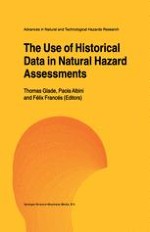2001 | OriginalPaper | Chapter
Landslide Hazard Assessment and Historical Landslide Data — An Inseparable Couple?
Author : T. Glade
Published in: The Use of Historical Data in Natural Hazard Assessments
Publisher: Springer Netherlands
Included in: Professional Book Archive
Activate our intelligent search to find suitable subject content or patents.
Select sections of text to find matching patents with Artificial Intelligence. powered by
Select sections of text to find additional relevant content using AI-assisted search. powered by
By definition, landslide hazard assessments must define the probability of landslide occurrence for a given region, area and/or time. If spatial information such as landslide distribution after a single landslide event is used for hazard analysis, the resulting hazard assessment is based purely on spatial components. Another approach for establishing the probability of occurrence involves time. As soon as temporal information is included, the need for historical data is obvious. Probabilities may then be calculated by using data on recent and past landslide failures, by means of recurrence intervals of the triggering agent or by a combination of both. These approaches lead, however, to temporal landslide hazard assessment. The ultimate step towards a comprehensive landslide hazard assessment is to combine both spatial and temporal probabilities. This increases the demand on reliable historical landslide data.Different ways of approaching landslide hazard assessments are given using examples from Germany and New Zealand. It is shown with these examples that the different approaches vary in their input requirements, and also that, along with increasing complexity, different potential applications of the resulting landslide hazard assessments are possible.
